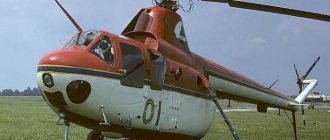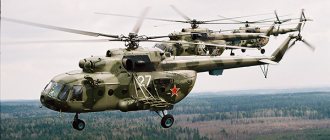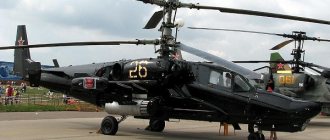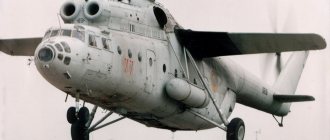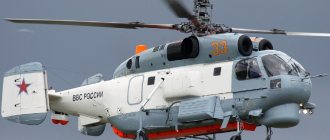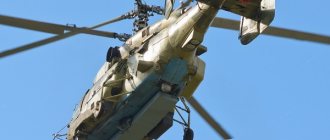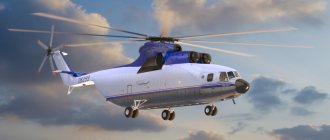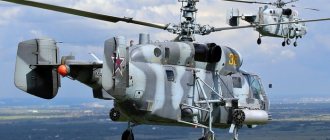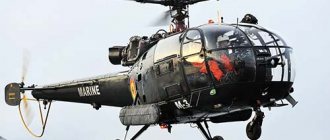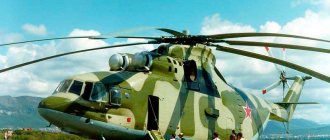The Ka-62 helicopter was built on the Ka-60 model, the fuselage interior of which was made in passenger and cargo versions. A transport-type cabin with a volume of up to 6 m2 accommodates about ten passengers in economy class and six in VIP class. The helicopter is also capable of transporting cargo weighing 450 kg in a mechanized manner. The model of this helicopter was demonstrated for the first time at an international aviation show on the territory of VDNKh.
Ka-62 – video
The Ka-62's cockpit featured innovative shock-absorbing seats and an instrument panel, which was based on a liquid crystal display for the first time in the Russian helicopter industry. It was created by a team of NIIAO authors, not without the participation of B. Gubarev and V. Krygin. For almost the entire period of the 90s, OKB employees actively demonstrated the new helicopter at all air shows to be able to find buyers. In parallel, negotiations are underway with European firms and companies about the possible joint deployment of helicopter production. The Ka-62 is the first aircraft from Kamov OJSC of the helicopter type, designed using a single-rotor design, and the tail rotor is located in the vertical tail. First of all, the main tilt of the helicopter was made for cruising speed, reducing fuel consumption and increasing weight efficiency.
Thanks to cooperation with TsAGI, theoretical and experimental research carried out jointly, it was possible to reduce aerodynamic drag. It also became possible to use updated profiles, and improved blade configurations resolved the problem of increasing propulsive and relative efficiency. OKB and TsAGI together were able to achieve maximum aerodynamic equivalent quality.
The tail rotor is multi-blade. The airframe and propeller blades are 60% made of composite polymer materials. The glider is distinguished by perfect contours, a three-line landing gear with a tail support and an impressive transport and passenger cabin. The power plant is represented by modular design engines (new generation), developed at the Rybinsk Engine Design Bureau. Unlike the basic military model, the civilian Ka-62 has higher cruising speed, transport performance, fuel efficiency and wide door openings in the transport cabin on both sides.
Thanks to the spacious fuselage, the helicopter can be used for civil transport in comfort and for transporting cargo, which can be placed internally and externally on a sling. High speed allows the helicopter to be used when emergency medical care is needed or in emergency rescue situations. The Ka-62 can be used as a patrol helicopter or ice reconnaissance vehicle.
Since the OKB employees initially planned to promote the helicopter to other countries, its design was carried out taking into account international requirements for safe flights. In the event of an accident with the power plant, landing is possible with one engine. If a rough landing is made, the energy-absorbing design of the seats and landing gear will ensure safety for the pilot and crew. The tail rotor of the keel is additionally protected. Among other things, the helicopter is equipped with fire and anti-icing systems.
An additional advantage of the helicopter is that it can be equipped both for flights in normal conditions in favorable weather, and with a special complex for flights in difficult and night flight conditions. If necessary, the engines and ionics in the helicopter can be foreign.
At the HeliRussia-2012 aircraft exhibition, a model of the Ka-62 with an updated helicopter design was presented. The appearance and layout have been preserved, but the chassis and power plant have changed completely. The Russian RD-600 turboshaft engine was replaced with the French TurbomecaArdiden 3G. The transmission and gearbox will be supplied from Austria. Production of the new helicopter is planned to begin at two and OJSC KumAPP. The first will be responsible for assembling the entire structure, and the second will be responsible for the creation and development of the steering and main rotors. The prototypes are managed by the Arsenevsky Helicopter Manufacturing Plant.
After tests carried out in 2013, it was decided to carry out a number of improvements. Certification will be carried out no earlier than 2015. The military model Ka-62 made its first test flight in March 2014. In July, the first three integrated flight and navigation systems KBO-62 were delivered for OP-1 and OP-2. The first delivery of helicopters for export is planned at the beginning of 2016.
Design of the Ka-62
The helicopter is single-rotor, with two gas turbine engines and a three-pair landing gear. It is distinguished by the massive use of CM (50% of the mass of the entire structure). The helicopter fuselage is characterized by an excellent aerodynamic profile. Metal frame with longitudinal beams and frames. The skin consists of laminated panels made of CM and carbon fiber. In turn, the fuselage includes four sections: the cockpit, the cargo-passenger compartment, and the tail boom with vertical and horizontal tails. For the crew, the cabin was specially conveniently glazed and a power lantern set from KM was installed. The doors open outwards. The pilot's seat is located on the right side of the cockpit to eliminate the possibility of duplication of controls.
The dimensions of the cargo-passenger cabin are 3.3 x 1.75 x 1.3 m with large doors. The tail boom has an ellipsoidal cross-section, thanks to which an uncontrolled stabilizer is installed. Its span is 3 meters. The beam has a vertical tail with a profile channel for the propeller. A keel with an asymmetrical profile is mounted above it. The three-wheel landing gear is retractable, and there is a self-orienting tail support with twin wheels. Retracts into the tail boom. The supports operate like a lever with nitrogen-oil shock absorbers, which are retracted to the side and front of the fuselage. In some modifications it is possible to install balloons.
The main propeller is four-bladed, the blades are fastened elastically. The bushing body is made of fiberglass. It is detachable, and the bushing itself consists of self-lubricating bearings of vertical hinges, torsion bars made of steel plates and elastic elements made of fiberglass. The one-piece composite blades form a rectangle with a swept tip. The double-circuit spar is presented in the form of a profile toe, along which lies a rubber coating (anti-icing system). Blade chord – 0.53 m.
The power plant includes two RD-600 gas turbine engines (take-off power - 955 kW, cruising power - 735 kW). An emergency power mode has also been thought out. The engines are located in a common fairing, the air intakes are located above the fairing. They are also equipped with an anti-icing air system. A digital electronic system is responsible for the regulation and complete redundancy of engine channels. A four-stage compressor, an annular combustion chamber and a drive turbine are integrated by a generator module. The free and driven turbines are two-stage. The launch is carried out using the AI-9 auxiliary installation.
The fuel system capacity is 1100 liters, distributed over four soft tanks. They are located at the bottom of the cabin with the booster pumps connected. The transmission consists of a two-stage main gearbox and a single-stage tail gearbox. The hydraulic steering drive of the control system, together with rigid rods, is combined into a common unit and includes loading mechanisms. The hydraulic system includes two autonomous subsystems. The first is responsible for feeding the steering drives, and the second regulates the wheel cleaning system.
From military to civilian
The history of the Ka-62 begins in the 1980s, when it became clear that the super-successful Mi-8 with its 4-ton payload was unprofitable to use when transporting smaller loads. Previously, similar tasks were handled by the Mi-4, which became obsolete by the end of the 1980s, and after its widespread decommissioning, the cargo transportation niche weighing about 2 tons remained empty. Then the Kamov Design Bureau begins to develop a new army helicopter labeled B-60.
The military set the task broadly: in addition to transporting goods and people, the new vehicle must be adaptable to the needs of reconnaissance, as well as perform combat functions. The first mock-up of the future helicopter was created in 1989. To increase flight speed, the Kamov Design Bureau for the first time abandoned their traditional coaxial design. The tail rotor was made in a closed form of the “finestron” type. The car was named Ka-60. A reconnaissance version was approved by the military under the name Ka-60R, and a deck version of the Ka-60K was also being developed.
Ka-60 at the MAKS-2001 air show
However, with the advent of the 1990s, funding for the project ceased and development had to be stopped. The designers are transferring some of the reconnaissance and combat functions of the Ka-60 to a new model - the attack reconnaissance Ka-52. In order to cover a wider range of the market, a decision was made to make a multi-purpose civilian Ka-62 helicopter based on the military model. Its full-size mock-up was shown at one of the first aerospace shows in Moscow, but there was not enough money for further development of the project.
Photo of Ka-62
Cabin of Ka-62
For different purposes and different markets
The Ka-62 is designed for passenger transport, offshore work, emergency medical services, aerial work and surveillance, cargo transportation inside the cabin and on an external sling, patrol and environmental monitoring. Thanks to the high service ceiling height and high thrust-to-weight ratio of the Ka-62 engines, it can also carry out search and rescue and evacuation operations in mountainous areas.
The Ka-62 design is designed for use in a wide range of climatic and geographical conditions at temperatures from -50 to +45 °C. Thus, a wide path is already open for export throughout the world. The helicopter can be operated on oil rigs and unprepared ground sites. Another advantage is the ability to store the helicopter outside the hangar.
Ka-62 at MAKS-2019. Photo: Alexander Utkin
The active stage of the project began in 2012 with the presentation of a model of a helicopter of an updated design at the international helicopter industry exhibition HeliRussia. Until 2017, when the Ka-62 flight model took to the skies for the first time, the helicopter was undergoing testing and modifications.
Serial production of the Ka-62, which is due to begin in 2020, is being prepared at the Progress enterprise named after. N.I. Sazykin in the Far Eastern Arsenyev. At the moment, three prototypes have been built here, which are intended to undergo a flight test cycle. The plans include the release of a corporate modification designed for 9 passengers, as well as police, rescue and offshore versions.
Flight performance
- The main rotor diameter is 13.8 m.
- Length with screws - 13.46 m.
- Height - 4.8 m.
- The empty weight of the helicopter is 4 tons.
- Maximum take-off weight - 6.5 tons.
- Engines - 2 x Turbomeca Ardinen3G.
- Maximum thrust at takeoff mode - 2 x 1776 hp.
- Maximum speed is 308 km/h.
- Cruising speed is 290 km/h.
- Dynamic ceiling - 5700 m.
- Static ceiling - 3300 m.
- Flight range - 770 km.
- Flight duration without additional tanks is 4.2 hours.
- Number of passengers - 14 people.
- The mass of cargo inside the helicopter is 2.2 tons.
- The weight of the cargo on the external sling is 2.7 tons.
- Crew - 2 people.
The first paperless engine
As mentioned above, the first production models of the Ka-62 will be equipped with foreign engines. However, work on a Russian analogue is already underway - as part of import substitution, the Rostec United Engine Corporation is creating a VK-1600V helicopter engine, which will be installed on the Ka-62 and other machines with a take-off weight of 5-8 tons. The new engine is being created to be as similar as possible to the current one to ease future transition and speed up certification.
This is the first aircraft engine in Russian history designed exclusively using 3D modeling. Moreover, all design documentation for it was released in electronic form. Digitalization of processes has already accelerated and simplified many stages of work on the power plant and in the future will allow more efficient development and support of the project.
Photo: United Engine Corporation
Another feature of the future engine will be that parts for it will be manufactured using 3D printing. The corresponding equipment has already been installed at the Rostec Additive Technologies Center. In the VK-1600V demonstrator, up to 70% of cast parts are replaced with parts “grown” on a 3D printer.
The first demonstrator engine VK-1600V, created by the St. Petersburg "ODK-Klimov", was presented at the MAKS-2021 aerospace salon, after which it went for the first tests. It is planned to obtain a type certificate for the engine in 2023, and launch mass production in 2024.
Power point
The sanctions of recent years have not affected cooperation on the production of KA-62. The engines of the new car are French power plants Ardiden 3G with a capacity of 1680 hp. With. Although earlier the designers planned to install domestic RD-600 turboshaft engines as engines for the KA-62. Why did you choose foreign options? It's all about the FADEC system, which is equipped with Ardiden 3G. It makes life easier for the pilot, reducing the workload on him, and providing better fuel efficiency. Ardiden 3G engines do not require an auxiliary power unit, saving significant space in the rear fuselage.
The transmission and shock-resistant fuel system of the KA-62 are supplied from abroad, or, more precisely, from Austria (). The remaining parts and components are of Russian origin, including the glass cabin, developed in St. Petersburg. Particularly worth noting is the five-bladed main rotor, which significantly reduces noise and vibration.
History of creation
The first ideas for the development of the KA-62 helicopter (more precisely, Kamov-62) date back to the mid-1980s. In 1990, the project was frozen. This was the beginning of an economically and politically difficult period for our country. It took much longer to develop into a finished model of the KA-62 than one might expect. In the 90s of the last century, numerous presentations of a helicopter model in order to find investors or organize a joint venture ended in failure. Work resumed only in 2011. The first test flight took place on April 28, 2016 in the Primorsky Territory. The aircraft coped with the tests “excellently.” Flight testing consisted of lifting off the ground, hovering and yawing. This made it possible to check the functioning of all on-board systems and the reliability of the power supply.
Let us recall that it was previously planned to fully put the KA-62 into operation in 2013, then in 2015. However, the model required a number of modifications during testing. This is due to the need to comply with all international standards of reliability, quality and maintenance. Today, many foreign buyers are showing interest in the KA-62. This is not only Europe, but also the countries of Latin America and Southeast Asia. The Russian Ministry of Defense also expects to put this helicopter into service.
